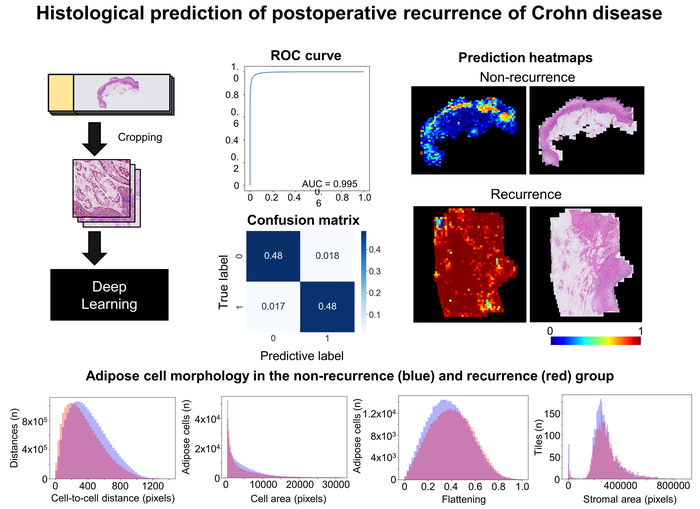Investigators built a model that predicts the postoperative recurrence of Crohn's disease with high accuracy by assessing histological pictures using an artificial intelligence (AI) tool that emulates how humans see and is programmed to identify and classify images.

Sixty-eight patients with Crohn's disease were classified according to the presence or absence of postoperative recurrence within two years. The investigators performed histological analysis of surgical specimens using deep learning EfficientNet-b5, a commercially available AI model designed to perform image classification. They achieved a highly accurate prediction of postoperative recurrence (AUC=0.995) and discovered morphological differences of adipose cells between the two groups. Image Credit: The American Journal of Pathology.
When comparing patients with and without illness recurrence, the AI tool found previously unreported abnormalities in adipose cells as well as significant disparities in the degree of mast cell infiltration in the subserosa or outer lining of the colon. The findings were published in Elsevier’s American Journal of Pathology.
Crohn's disease is a chronic inflammatory gastrointestinal disease that has a 40% postoperative symptomatic recurrence rate. Although scoring systems exist to assess Crohn's disease activity and the presence of postoperative recurrence, no scoring system exists to predict whether Crohn's disease will recur.
Most of the analysis of histopathological images using AI in the past have targeted malignant tumors. We aimed to obtain clinically useful information for a wider variety of diseases by analyzing histopathology images using AI. We focused on Crohn's disease, in which postoperative recurrence is a clinical problem.
Takahiro Matsui and Eiichi Morii, Department of Pathology, Osaka University Graduate School of Medicine
The researchers examined 68 Crohn's disease patients who had bowel resections between January 2007 and July 2018. The presence or absence of postoperative disease recurrence within two years following surgery was used to divide them into two groups.
Each group was divided into two subgroups, one for training and the other for validation of an AI model. Whole slide images of surgical specimens were cropped into tile images for training, annotated for the presence or absence of postsurgical recurrence, and then processed using EfficientNet-b5, a commercially available AI model for image classification.
When the deep learning model was evaluated with unlabeled photos, the findings showed that it correctly identified the images based on the presence or absence of disease occurrence.
The next step was to create prediction heat maps to identify locations and histological markers from which the machine learning algorithm could accurately predict recurrence. All layers of the intestinal wall were photographed.
The heatmaps revealed that the machine learning model predicted the subserosal adipose tissue layer correctly. The model was less precise in other regions, such as the mucosal and correct muscle layers. Images with the most accurate predictions were selected from the test datasets of non-recurrence and recurrence sets.
The photos with the greatest predictive findings all had fat tissue in them.
The researchers predicted that subserosal adipose cell morphologies differed between the recurrence and nonrecurrence groups because the machine learning algorithm made good predictions from photos of subserosal tissue. The recurrence group’s adipose cells were smaller, flatter, and had a lower center to center cell distance values than those in the nonrecurrence group.
Dr. Matsui and Dr. Morii added, “These features, defined as ‘adipocyte shrinkage’, are important histological characteristics associated with Crohn's disease recurrence.”
The researchers also speculated that the changes in adipocyte shape between the two groups were linked to some degree or kind of tissue inflammation.
They discovered that the recurrence group had a considerably larger number of mast cells infiltrating the subserosal adipose tissue, implying that the cells are linked to Crohn's’s disease recurrence and “adipocyte shrinking.”
This data is the first to correlate postoperative recurrence of Crohn's disease with the histology of subserosal adipose cells and mast cell infiltration, according to the researchers.
Dr. Matsui and Dr. Morii further stated, “Our findings enable stratification by prognosis of postoperative Crohn's disease patients. Many drugs, including biologicals, are used to prevent Crohn's disease recurrence, and proper stratification can enable more intensive and successful treatment of high-risk patients.”
Journal Reference:
Kiyokawa, H., et al. (2022) Deep Learning Analysis of Histologic Images from Intestinal Specimen Reveals Adipocyte Shrinkage and Mast Cell Infiltration to Predict Postoperative Crohn's Disease. AJPath. doi.org/10.1016/j.ajpath.2022.03.006.